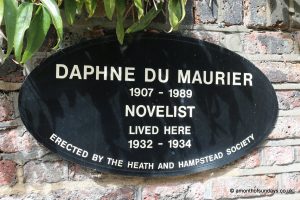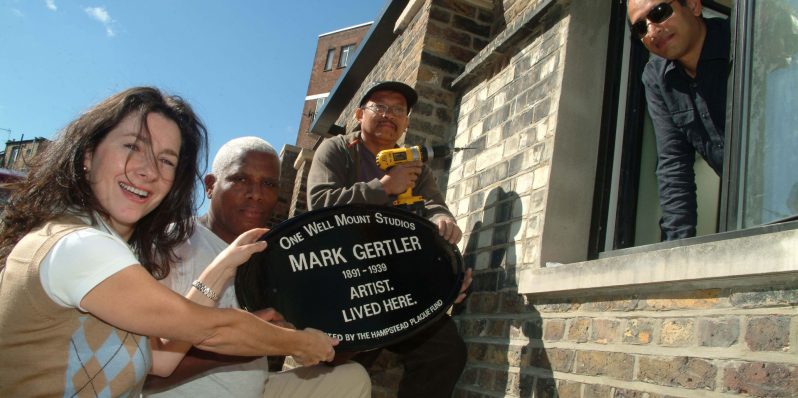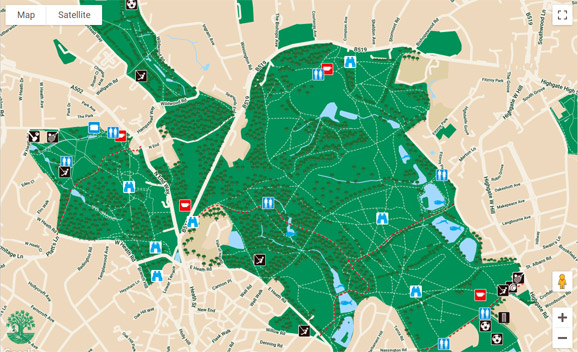by Juliette Sonabend.
 Hampstead has been home to many famous and influential people, from those who have changed the way we think, to those who have changed the way we shop.
Hampstead has been home to many famous and influential people, from those who have changed the way we think, to those who have changed the way we shop.
These great people have distinguished themselves in the world of politics, business, science, literature, art, music, theatre and film. From Sir Henry Vane, the Parliamentarian beheaded in 1662, to Sir Henry Cole, the Victorian postal reformer who originated the custom of sending Christmas cards, and from John Constable, the artist, to John Lewis the draper, Hampstead provided the home they sought.
Commemorative plaques form a tangible link between these illustrious earlier residents and the buildings of Hampstead. Their enticing presence fascinates people of all ages and backgrounds, residents and visitors alike. They instruct and entertain, they bring the past into the present, and they perpetuate their memory, making buildings their own biographers, and are a source of local pride. Plaques also mark buildings of significant historical or architectural note, informing us of their history or contribution to the built environment.
There are over 75 such plaques in Hampstead around half of which are the blue (formerly brown) round plaques erected by English Heritage or its forebears, the Society of Arts, London County Council and Greater London Council. The other half are the distinctive black oval Hampstead plaques of The Heath & Hampstead Society.
It is now over 10 years since Frank Harding invited me to join him on a new panel to focus on the Society’s historical interests and to administer and perpetuate the Hampstead plaque scheme. So, after a decade of commemorating Hampstead and on this the Society’s 120th anniversary I am happy to take a moment to reflect upon our work.
The Hampstead Plaque Fund was established in the 1980s by Ralph Wade to commemorate former residents of Hampstead who, for various reasons, did not qualify for an English Heritage blue plaque and also to commemorate buildings of architectural interest or those which contributed to the history of Hampstead.
In 1994, the Heath & Hampstead Society took over the running of the scheme and added four new plaques to the 25 existing ones. Our first task in 2006 was to survey each of the 29 plaques that we inherited. We located, catalogued and photographed each plaque; we identified 10 plaques requiring significant restoration (completed in 2007). We replaced two plaques where the condition was too poor to be saved. That project took three years to complete! Our next and on-going task remains the selection and installation of new plaques. We have installed six new plaques since taking over the scheme.
The Society’s black plaque scheme is totally independent of the English Heritage scheme. However, we collaborate with them to ensure that we do not duplicate our efforts.
Plaque selection criteria
The Society broadly follows the same guidelines as those established by English Heritage. The person under consideration needs to meet the following criteria:
• to have been dead for 20 years or to have reached the age of 100, thus allowing sufficient time for the candidate’s reputation to mature and to have proved to be enduring
• to have lived in the actual building being commemorated, not in a later property constructed on the site
• to have made a significant contribution in their field
• to be recognisable to a well-informed passer-by
• to have lived in Hampstead for a meaningful amount of time
• if a foreigner, to have an international reputation
• where a building is to be commemorated, to be of architectural significance or of relevance to the history of Hampstead.
Selection process
We encourage our membership, as well as the general public, to make suggestions. These come from Hampstead residents, as well as from those further afield with a particular interest in the person proposed, from later residents of the same house, or from relatives.
A list of proposals is collated throughout the year and each suggestion is submitted for consideration at our semi-annual panel meetings. Proposals are considered on their merits. Usually no more than four are selected by the panel for further research and consideration. Research is then undertaken to confirm proof of residence and corroborate historical details. The list of approved recommendations is put forward to the General Committee of the Society for approval. Consent for the erection of a plaque is then sought from the property owner. Whilst planning permission is not required, if a building is listed, building consent from Camden is obligatory. After the agreement of the design, content and location with all parties involved, the plaque is manufactured, erected and, where appropriate, an unveiling ceremony is held. This process can take anything from four months to four years!
Design, manufacture and fixing
Our plaque designs have remained virtually unchanged. They are still oval in shape and measure 750mm by 385mm. The materials have of course evolved. The original plaques were cast in aluminium, etch-primed and powder coated, with the lettering hand-painted in gold. Now they are fabricated from 3mm thick solid sheet aluminium and relief-etched with a raised border and text. The plaques are stove-enamelled, with an antique black background and ivory lettering, which has been found to be more durable. The plaques are surface-mounted by a delightful gentleman whose family has lived in Hampstead for generations.
The Society places upon the home owner no obligation or responsibility for the plaque. The plaque remains the property of the Society which is liable for its maintenance. As I noted above, we have installed six new plaques since taking over the scheme. Whilst this figure sounds small, one has to factor in the human element: not all property owners wish to draw attention to their homes, sometimes the political leanings or morals of the candidate upset a current owner and sometimes residents just cannot decide or agree on what they want. And often the candidate’s tenure of the property is too short to justify a plaque. So, this work often requires patience, perseverance and sometimes great charm!
Commemorative plaques and their relevance in 2017
So, what does the future hold? What relevance does a solid message placed on a building hold in this world of ephemeral pleasures, instant access to information, and endless streams of news? The answer is that their relevance is increasingly important and understanding their contribution to our daily lives has never been easier. Combining these solid commemorations with the ability to research the history of the site on our smartphones means that the plaques can serve as a springboard for our curiosity and add relevance and context to our historically rich neighbourhood.
If we take three of our more celebrated plaque recipients, it is clear that their contribution is as relevant today as ever and, as such, they are enduring aids for teachers, historians and the public at large.
George Orwell (77 Parliament Hill) – his dystopian novels 1984 and Animal Farm are rarely out of the bestseller list, with the former topping the list after the inauguration of Donald Trump. His observations are universal and as relevant as the day he wrote them.
Sir Edward Elgar (44 Netherhall Gardens) – Land of Hope and Glory is an annual fixture at the Last Night of the Proms. His sentiments echo the post-Brexit referendum zeitgeist.
Marie Stopes (14 Well Walk) – her work, as pioneer of the Family Planning Movement, remains vitally important, especially in the current heated climate of the worldwide debate over a woman’s control of her body.
People are passionate about plaques, they connect people with place and they bring our streets to life. They fascinate, beguile and charm. I am thrilled to be running the Hampstead Plaque Scheme together with Frank Harding. I would now like to consider how we update our information and put pertinent biographies on our website, enabling the siting of a plaque to be the beginning of a journey which continues via the palm of our hand and extends through the internet as far we wish to go.
We run Hampstead plaque tours during the spring and summer months – the next tours are scheduled for 13 and 20 May (if you wish to join one of these walks, contact Frank Harding at frankaharding@btinternet.com) and of course we always welcome suggestions for new plaques.
We have already been granted consent for three new plaques in 2017 and we are delighted to be able to continue sharing the story of Hampstead’s former residents and their sustained contribution to our ever-changing world. For further information, please feel free to contact us at juliette@sonabend.co.uk or frankaharding@btinternet.com

